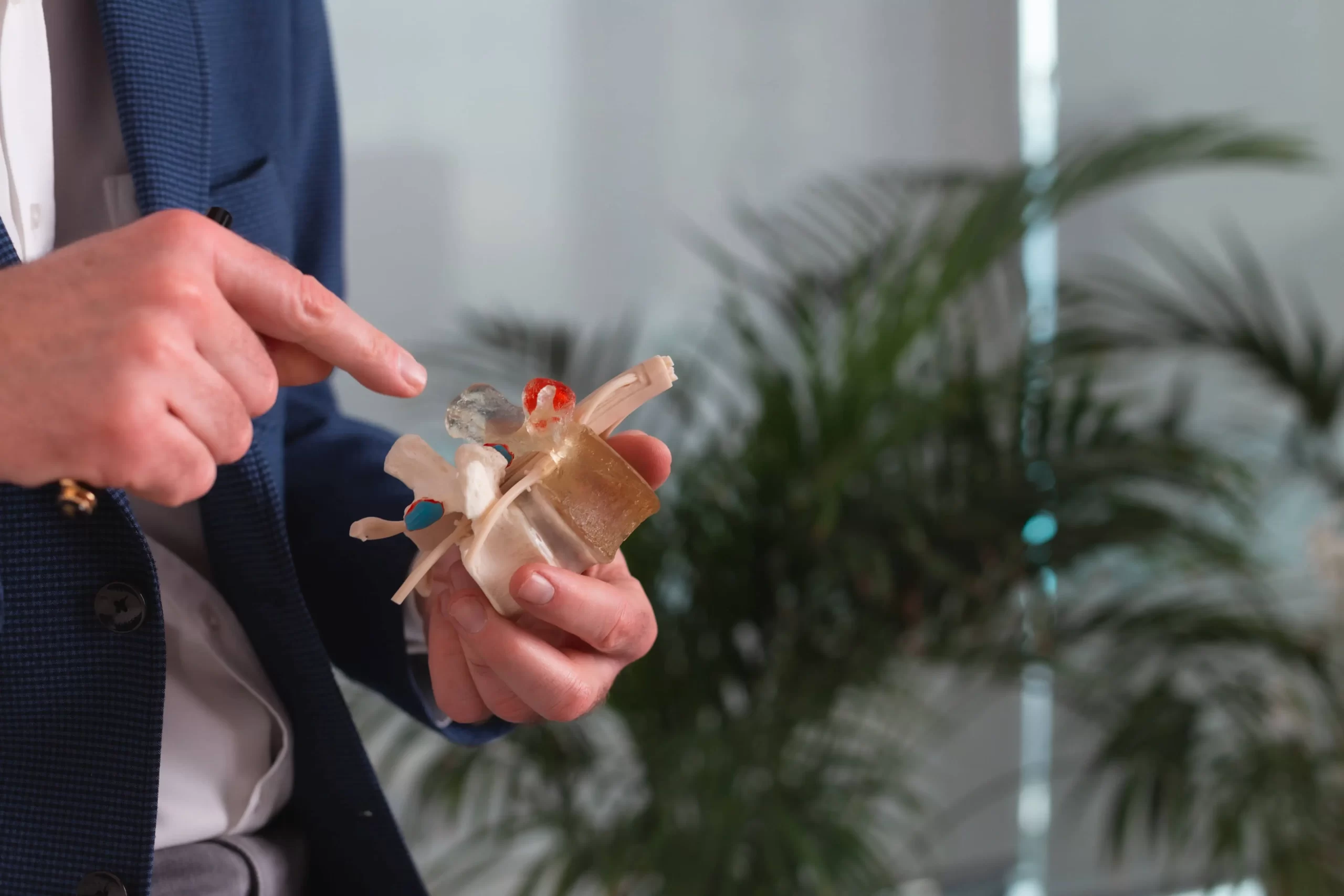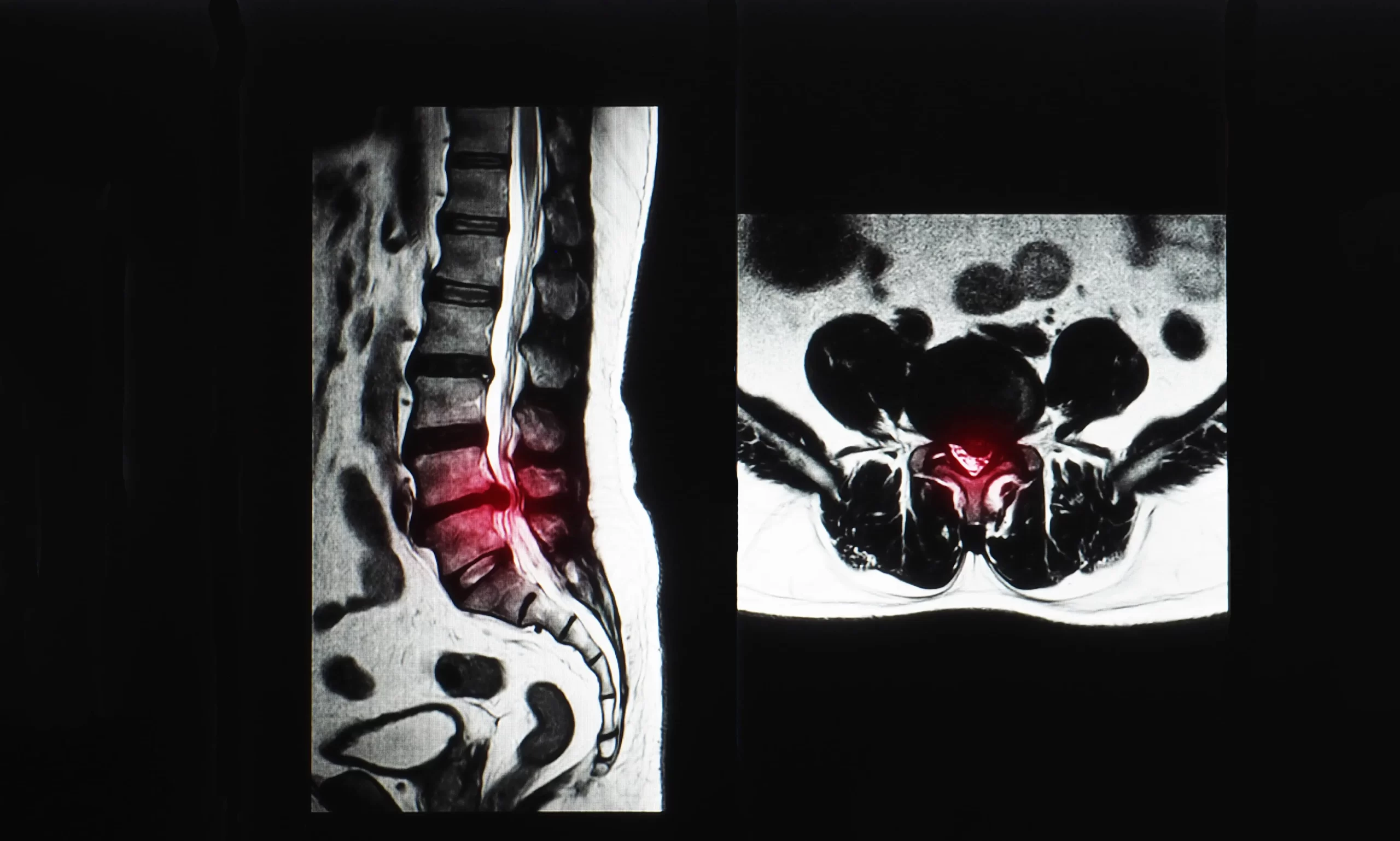Lumbar Hernia
On this page, we will try to explain in detail about how herniated disc occurs, its symptoms, causes, how it is diagnosed and its surgery. I wish you all healthy days.
How Does a Lumbar Hernia?
Lumbar hernia occurs when the structure we call the disc between the lumbar region spines ruptures and compresses the spinal sac and nerves.


Causes of Lumbar Hernia
In the disease known as lumbar degenerative disc disease in medicine and known as lumbar hernia among the people, 2 types of lumbar hernia are seen. The first of these is when the capsule on the outside of the disc structure between the two vertebrae remains intact and the structure of the disc deteriorates and its height decreases, and the other is caused by the rupture of this capsule and the outflow of the disc material under the pressure of one or both of the nerves leading to the spinal cord sac or leg. Although the causes of lumbar hernia are not known exactly, familial predisposition, degeneration caused by aging, excessive weight gain and sudden tension due to heavy load lifting can be counted among the reasons.
Lumbar Hernia Symptoms
Among the symptoms of lumbar hernia, the most common are; low back or leg pain, numbness in the legs or feet, difficulty walking, and loss of strength in the legs or feet.Patients often apply to a neurosurgeon with these complaints.Our patients usually complain of low back pain at first, but over time, they begin to feel the pain in their legs as a result of the disc (hernia) fragment coming out of the torn disc compressing the nerve roots. In the later stages of lumbar hernia, patients may experience loss of strength in the legs or feet, urinary or stool incontinence or sexual dysfunctions.


How is the Diagnosis of Lumbar Hernia?
In the diagnosis of the disease; In addition to clinical examination findings, X-ray, MRI (Magnetic Resonance), and CT (Computed Tomography) are often used. Electrophysiological examination of the nerves we call EMG may be required. The picture that emerges as a result of all examinations and findings helps to revealwhether the person has a herniated disc or not. Waist radiographs (x-ray) are the first radiological imaging method that can be used in patients who apply to health institutions with low back pain. In general, the shooting of these films is carried out in 3 directions and thanks to the lumbar radiographs, the alignment of the patient's vertebrae, possible fractures and degenerative changes can be detected. The most sensitive examination in the examination of the bone structure of the spine is computed tomography (CT). Thanks to the tomography images, calcified or herniated discs can be detected. Magnetic resonance imaging (MRI), another radiological imaging method, is considered the gold standard diagnostic tool in patients with suspected herniated disc. This procedure, which has a diagnostic accuracy of approximately 97%, is very sensitive because it can also image the soft tissue in detail.
Surgical Treatment of Lumbar Hernia
The first surgery for a herniated disc was performed in 1934 by two surgeons named Mixter and Barr. Technology in medicine has advanced very rapidly and patients have been operated on first with open surgery technique, then with microdiscectomy (microsurgery), and especially in the last 7-8 years, fully closed lumbar hernia surgery, in other words, full endoscopic lumbar hernia surgery, has become current.


Microdiscectomy
One of the methods used in surgery for years is microdiscectomy (microsurgery). Microdiscectomy (microsurgery) is actually a type of open surgery technique. The differenceis that it is made under a microscope and with a slightly smallerincision. In patients who are operated with microdiscectomy(microsurgery), an incision of 2.5-3 cm is made, and then, in this surgical technique, the surgical area where the hernia is located is reached by stripping the muscle tissue and partially removing the bone tissue called the lamina. After the operation performed with this method, patients face long-term back pain throughout life due to the irregular adhesion of the muscles to the spine and the removal of bone tissue. The duration of the operation performed with microdiscectomy (microsurgery) is 60 minutes, but the total time between the patient's exit and arrival from the room is about 2.5 hours.The success rate after surgery with this method is 95%.The rate of risks that may occur in surgery is between 0.3-2%.
Lumbar Hernia Surgery Options
Severe loss of strength in the legs or feet, incontinence of urine or stool, or loss of sexual functions in the patient with a herniated disc requires the patient to be operated under emergency conditions. In addition, only patients who present with intense pain are treated with medication, rest or physical therapy program for 20 days.However, at the end of this period, patients whose pain problem cannot be eliminated can be re-evaluated and taken to the surgical process. When we look at the surgical treatment options of lumbar hernia, we come across three different surgical methods. The first of these is open lumbar hernia surgery (open discectomy), the other is microdiscectomy (microsurgery) and the last one is full closed lumbar hernia surgery, also known as full endoscopic lumbar hernia surgery.
Fully Closed Lumbar Hernia Surgery (Full Endoscopic Lumbar Hernia Surgery)
In this surgical technique, the surgery is performed by entering the lumbar region from the back, back-side or side. In all types of endoscopic procedures, a much smaller skin incision (0.6 cm) is used than the operation performed with open or microsurgery. In the last 10 years, endoscopic methods have become very up to-date in medicine and have gained an important place in brain surgery. Daily hospitalization is performed for our patients, patients walk 4 hours after the operation performed with this method and are discharged after 6 hours. Early mobilization allows the patient to spend the day more comfortably and to make the toilet requirement unaided. Surgeries are performed under general or epidural anesthesia. In the fully closed surgical technique performed by entering from the middle or side according to the location of the hernia formed in the lumbar region; It is performed by viewing the surgical site through a very high-resolution screen with the help of a 4 mm endoscope inserted into the herniated disc area through a 0.6 cm incision. The most important advantage of this surgery is that it does not require muscle tissue stripping (dissection) and bone tissue removal, which is mandatory as in the microdiscectomy (microsurgery) method.
This ensures that the patient can be activated early and participate in daily life much more quickly with much less low back pain after surgery. For these reasons, fully closed lumbar hernia surgery is a surgery with very high patient comfort. In addition, in the operation performed with this technique, there is much less bleeding than the operation performed with microdiscectomy (microsurgery) and the scar tissue that develops after the operation is almost non-existent. We recommend our patients a
Open Lumbar Hernia Surgery (Open Discectomy)
This surgical technique is a surgery with very low postoperative comfort due to the size of the wound made through a skin incision of 5 to 8 centimeters long. Patients have to rest on bed rest for a long time after surgery. The biggest reason for this is the large muscle dissection performed in the opened surgical area, in other words, muscle stripping. Again, in this surgery, bone tissue is removed from the area called the lamina, which is the posterior part of the spine. Due to the irregular adhesion of these muscles to the spine after surgery and bone tissueextractionn, patients will face long-term back pain throughout life.
Before Lumbar Hernia Surgery
The most important thing to do before surgery is to examine our patients. After the examination, we perform radiological or electrophysiological examinations (electromyography is popularly known as nerve measurement test), examine the results, and then decide on surgery. Here again, the most important criterion is to decide which surgical method will be applied to our patient (fully closed lumbar hernia surgery or microdiscectomy (microsurgery)) to explain all the details of the operation to our patient and to ensure that there is no question mark in his mind. We direct the patients we decide to operate to the patient consultants in the hospital groups we work with. Patients go to the hospital in the morning on an empty stomach and are admitted to the laboratory by patient consultants for pre-operative tests and Covid-19 tests. Following the results of the tests on the same day, our patients are evaluated by anesthesiologists. The patient, who receives anesthesia approval for surgery, goes to the hospital on an empty stomach in the morning on the day of surgery, is hospitalized and then taken to the operation at the appointment time. One of the most important questions for the relatives of the patients who are planned to be taken to the operating room is how long the surgery will be. Before the operation, we give detailed information about the operation time to our patient and the patient's relatives and after the end of the operation, the patient's relatives are informed that the operation is over. At the same time, the relatives of the patients can also follow the stage of their patients' surgery through the information screen.
This ensures that the patient can be activated early and participate in daily life much more quickly with much less low back pain after surgery. For these reasons, fully closed lumbar hernia surgery is a surgery with very high patient comfort. In addition, in the operation performed with this technique, there is much less bleeding than the operation performed with microdiscectomy (microsurgery) and the scar tissue that develops after the operation is almost non-existent. We recommend our patients a moderate rest period of 3 days at home after surgery. In this process, our patients can meet all their personal needs themselves. Office workers can return to work on the 4th day, and those who work hard can return to work after 15 days. In fully closed lumbar hernia surgery, the total time between the patient's exit and arrival from the room is approximately 2.5 hours, the success rate in the operation and the rate of risks that may occur in the operation are similar to microdiscectomy (microsurgery).
Does Hernia Recur?
Lumbar disc hernia, also known as lumbar hernia, is one of the most common diseases we encounter in brain and nerve surgery practice. I would like to clarify a question asked by all our patients on this subject .This is the question 'Does the herniated disc recur after surgery?'The answer is, 'Yes, it can relapse.' In the researches conducted to date, the recurrence rate varies between 5-11%. This rate is similar in all surgical methods. What is the concept we call relapse ?There is confusion in the minds of our patients about this .This is because the concept of relapse is not well explained enoug h.As you know, when defining a herniated disc, it is defined by the numbers of the lumbar vertebrae and which side they are on. For example, right L4-5 disc herniation (herniated disc).In order for this case to be counted as a recurrence, the patient must have a right L4-5 disc herniation (herniated disc) agai n.A herniated disc that is on the left side (that is, on the opposite side of the operated side) or at another distance at the same distance does not mean recurren ce.This means a new herniated disc and should not be called a relapse.
Lumbar Hernia Surgery Prices

We receive a large number of patient calls who want to know the price for surgery. The publication of surgery prices in a digital environment open to all our patients is not appropriate in terms of professional ethical rules .We make the surgery fees of our patients according to the pricing list in the "Physician Practices Database" used by all other private hospitals and prepared by the Turkish Medical Association. Thus, our patients know according to which standards the price offered to them is determined, make sure of the transparency of the price and have the opportunity to compare prices.

Exercise After Hernia Surgery
We start exercise programs for our postoperative patients in the 2nd month after surgery. Our patients should do the waist exercises we give regularly at least 3 days a week. Often, our patients stop doing their waist exercises after a period. Postoperative exercises should be continued throughout life.
Recovery Process After Lumbar Hernia Surgery

- If your surgery is performed with a fully closed method, our patients stand up after 4 hours, if it is performed with open lumbar hernia surgery, microdiscectomy (microsurgery) method, after 8 hours. Afterwards, our patients who underwent surgery with a fully closed method after 6 hours; Our patients who have
- In our patients who have decided to operate in today’s technological conditions, our primary choice is fully closed lumbar hernia surgery or full endoscopic lumbar hernia surgery. In this surgical method, the postoperative period is very comfortable compared to other methods .Patients stand up after 4 hours and are discharged in 6 hours if they wis h.Office workers can return to their work life after 4 days.
- After being discharged after surgery, it is okay to go home sitting in the vehicle. If possible, traveling in the front seat and seat back to 110 degrees will minimize the possibility of pain.
- If you need to climb stairs in the first 3 days, climb the steps one by one, bringing one foot next to the other on each step.
- You can eat while sitting. When you sit down to eat, make sure you have back support and, if possible, sit in a chair and eat.
- Take care to behave as you are taught when sitting and leaving.
- Make sure that your bed is suitable for waist health after surgery. Do not sleep on the sofas and sofas in your next life.
- When getting out of bed, first turn right to your side, then take a sitting position with your hands on the side support and get up like that.
- I will give you the necessary information to take a bath after the wound site control.
- When you run out of medications given to you by me when you are discharged (unless told otherwise), you do not need to take the same medications again.
- Definitely use a toilet bowl for the toilet.
- Take care to wear your shoes while sitting. Shoes with or without very high heels are not suitable for our female patients. Shoes with medium-height or padded heels will make you more comfortable.
- When taking something from a height, try to get it by going to an appropriate height.
- You should start the waist exercises given to you after 2 months. Initially, there may be slight pain in your movements. But over time, your movements will become painless.
- Do not leave yourself free to sit in a chair or chair for the rest of your life after surgery. Move to a sitting position slowly and controlled. When lifting, support your knees or the armrests on the sides of the seat.
- Those who have undergone surgery with the fully closed method from the 3rd day; Our patients who have undergone surgery with open lumbar hernia surgery, microdiscectomy (microsurgery) 7. From the day he can go out and start walks. Start the walks in a short time (10-20 minutes). Increase by 10 minutes every 3 days.
- If you work in the office, our patients who have undergone surgery with a fully closed method after 4 days; those who have undergone surgery with open lumbar hernia surgery, microdiscectomy (microsurgery) can return to work after 20 days. Our patients who were operated with a fully closed method from those working in more severe work conditions were required to work for 15 days; those who have undergone surgery with open lumbar hernia surgery, microdiscectomy (microsurgery) can return to work after 45 days.
- In all 2 surgical methods, take care not to carry weight for the first 30 days, and then not to carry more than 6 kg in total in both hands. When lifting weights, squat and lift the weight as close to your body as possible.
- Regardless of the method, try not to gain weight after surgery, and if you have excess weight, try to lose it. For this, it will be appropriate to get professional support from the diet department.
- Avoid physical contact sports after surgery. Prefer walking and swimming if possible.
- 3 days if you have had your surgery with a fully closed method; If you have undergone surgery with open lumbar hernia surgery, microdiscectomy (microsurgery), do not drive for 15 days. Then you can use it for short distances in the city. Long-distance travels, if you are driving the vehicle, those who have surgery with the fully closed method after 7 days; those who have surgery with open lumbar hernia surgery, microdiscectomy (microsurgery) can do it after 30 days. However, stop every 1.5 hours, take a break for 10 minutes, take a short walk and continue on the road.
- Short-haul air travel with the fully closed method after 3 days; those who have surgery with open lumbar hernia surgery, microdiscectomy (microsurgery) can do it after 10 days. Longer journeys (across the ocean) can be performed after 7 days in those who have a fully closed method, and 30 days in those who have an open herniated disc surgery and microdiscectomy (microsurgery).In all 2 surgical methods, the plane should be moved around by getting up every 1.5 hours. After the operation, those who work at the desk should use a chair with a waistsupported orthopedic feature and get up every hour for 5 minutes, walk around the office and then sit down again.